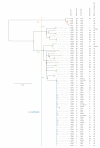International travel as source of a hospital outbreak with an unusual meticillin-resistant Staphylococcus aureus clonal complex 398, Denmark, 2016
- PMID: 31640842
- PMCID: PMC6807253
- DOI: 10.2807/1560-7917.ES.2019.24.42.1800680
International travel as source of a hospital outbreak with an unusual meticillin-resistant Staphylococcus aureus clonal complex 398, Denmark, 2016
Abstract
In May 2016, an unusual outbreak with the Panton-Valentine leukocidin-positive human variant of meticillin-resistant Staphylococcus aureus (MRSA) clonal complex 398 occurred among mothers and infants in the maternity unit of a Danish hospital. MRSA sharing genotypic and phenotypic characteristics was confirmed in 36 cases, including 26 patients, nine household members and a healthcare worker (HCW) who had contact with all the patients. The national MRSA database contained 37 seemingly unlinked MRSA cases whose isolates shared the same genotypic and phenotypic characteristics as the outbreak strain. Whole genome sequencing showed that three of these isolates clustered together with the 36 outbreak isolates, suggesting spread outside the hospital. The HCW and 21 of 37 cases from the national MRSA database had links to south-eastern Asia, where the outbreak strain is endemic. These findings suggest that the HCW acquired the outbreak strain while travelling in south-eastern Asia and then introduced it into the hospital; from there, it spread within the patients' households and into the community. Screening of travellers returning from countries with high levels of MRSA could be an important intervention to prevent spread of these bacteria into hospitals via patients or HCWs.
Keywords: MRSA; PVL; Panton-Valentine leukocidin; epidemiology; hospital outbreak; meticillin-resistant Staphylococcus aureus; surveillance; travel.
Conflict of interest statement
Figures



References
-
- Cassini A, Högberg LD, Plachouras D, Quattrocchi A, Hoxha A, Simonsen GS, et al. Attributable deaths and disability-adjusted life-years caused by infections with antibiotic-resistant bacteria in the EU and the European Economic Area in 2015: a population-level modelling analysis. Lancet Infect Dis. 2019;19(1):56-66. 10.1016/S1473-3099(18)30605-4 - DOI - PMC - PubMed
-
- European Centre for Disease Prevention and Control (ECDC). Surveillance of antibiotic resistance in Europe 2016. Annual Report of the European Antimicrobial Resistance Surveillance Network (EARS-Net). Stockholm: ECDC; 2017. Available from: https://ecdc.europa.eu/sites/portal/files/documents/AMR-surveillance-Eur...
-
- Danish Integrated Antimicrobial Resistance Monitoring and Research Programme. DANMAP 2016 - Use of antimicrobial agents and occurrence of antimicrobial resistance in bacteria from food animals, food and humans in Denmark. Copenhagen: Statens Serum Institut, National Veterinary Institute and National Food Institute, Technical University of Denmark; October 2017. [Accessed 15 Nov 2018]. Available from: https://www.danmap.org/-/media/arkiv/projekt-sites/danmap/danmap-reports...
-
- Böcher S, Skov RL, Knudsen MA, Guardabassi L, Mølbak K, Schouenborg P, et al. The search and destroy strategy prevents spread and long-term carriage of methicillin-resistant Staphylococcus aureus: results from the follow-up screening of a large ST22 (E-MRSA 15) outbreak in Denmark. Clin Microbiol Infect. 2010;16(9):1427-34. 10.1111/j.1469-0691.2010.03137.x - DOI - PubMed
-
- Danish Health Authority. Guidance on preventing the spread of MRSA. 3rd edition. Copenhagen: Danish Health Authority; December 2016. [Accessed 15 Nov 2018]. Available from: https://www.sst.dk/da/sygdom-og-behandling/smitsomme-sygdomme/mrsa/~/med...
MeSH terms
Substances
LinkOut - more resources
Full Text Sources
Medical
